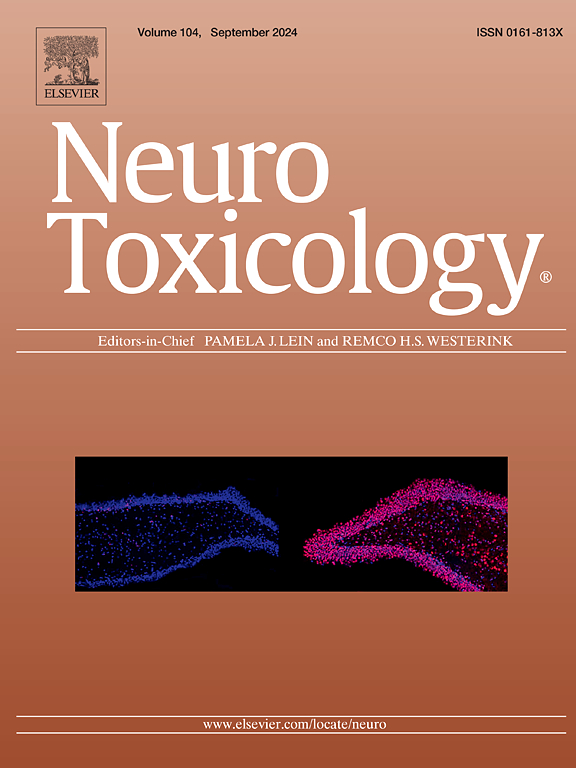cth-2/mpst-1依赖性H2S缺乏增强秀丽隐杆线虫的丙烯腈急性毒性。
IF 3.9
3区 医学
Q2 NEUROSCIENCES
引用次数: 0
摘要
丙烯腈(AN)是一种有毒的无色至淡黄色液体,广泛用于工业生产,与神经毒性有关。虽然我们之前的研究显示了哺乳动物细胞中an诱导的神经毒性与气体递质硫化氢(H2S)之间的相关性,但关于动物整体毒性和特异性神经损伤的实验证据仍然有限。我们旨在利用H2S的遗传优势,进一步探索H2S与AN诱导的秀丽隐杆线虫(C. elegans)急性毒性之间的分子关系,为H2S供体作为AN解药的有效性提供实验依据。在本研究中,我们通过死亡率、运动行为、幼鸟数量、多巴胺能神经元形态和氧化应激的变化证明急性AN暴露会导致毒性。通过亚甲基蓝分光光度法和醋酸铅纸法验证了AN对H2S含量的抑制作用。此外,AN显著降低了3-巯基丙酮酸转移酶(3-MPST)介导的H2S合成活性和相应编码基因mpst-1的转录水平,但对以l -半胱氨酸为共同底物的胱硫氨酸β合成酶(CBS)/胱硫氨酸γ裂解酶(CSE)介导的H2S合成活性和H2S氧化代谢酶的mRNA水平没有影响。cth-2和mpst-1突变显著下调H2S含量和相应的H2S合成活性,并进一步增强了an诱导的毒性反应,包括致死性、卵数和寿命。相比之下,H2S供体GYY4137显著降低了an损伤的存活率、体弯曲和多巴胺能神经元的形态。我们的研究结果表明H2S的减少介导了丙烯腈的急性毒性。本文章由计算机程序翻译,如有差异,请以英文原文为准。
cth-2/mpst-1-dependent H2S deficiency enhances acrylonitrile acute toxicity in Caenorhabditis elegans
Acrylonitrile (AN) is a toxic, colorless to pale-yellow liquid extensively used in industrial production and has been linked to neurotoxicity. Though our previous study showed a correlation between AN-induced neurotoxicity and gasotransmitter hydrogen sulfide (H2S) in mammalian cells, experimental evidence on overall animal toxicity and specific neurological injury is still limited. We aimed to further explore the molecular association between H2S and AN-induced acute toxicity in Caenorhabditis elegans (C. elegans) by using its genetic advantages, and provide experimental evidence for the validation of H2S donors as AN antidote. In the present study, we demonstrated that acute AN exposure resulted in toxicity as evidenced by changes in death rate, locomotor behavior, brood size, dopaminergic neuron morphology, and oxidative stress. Notably, AN inhibited the H2S content, which was double-examined by methylene blue spectrophotometry and lead acetate paper assay. Furthermore, AN significantly decreased 3-mercaptopyruvate sulphurtransferase (3-MPST)-mediated H2S synthesizing activity and the transcription level of the corresponding coding gene mpst-1 but had no effect on the cystathionine β synthetase (CBS)/cystathionine γ lyase (CSE)-mediated H2S synthesizing activity using L-cysteine as a common substrate and the mRNA levels of H2S oxidative metabolism enzymes. cth-2 and mpst-1 mutations significantly downregulated the H2S content and the corresponding H2S synthesizing activity, and further enhanced the AN-induced toxicity response including lethality, brood size and lifespan. In contrast, H2S donor GYY4137 significantly attenuated the AN-damaged survival rate, body bends, and dopaminergic neuron morphology. Our findings demonstrated that the reduction of H2S mediates the acute toxicity of AN.
求助全文
通过发布文献求助,成功后即可免费获取论文全文。
去求助
来源期刊

Neurotoxicology
医学-毒理学
CiteScore
6.80
自引率
5.90%
发文量
161
审稿时长
70 days
期刊介绍:
NeuroToxicology specializes in publishing the best peer-reviewed original research papers dealing with the effects of toxic substances on the nervous system of humans and experimental animals of all ages. The Journal emphasizes papers dealing with the neurotoxic effects of environmentally significant chemical hazards, manufactured drugs and naturally occurring compounds.
 求助内容:
求助内容: 应助结果提醒方式:
应助结果提醒方式:


